During the great depression era, many families lost their source of income, and unemployment was at an all-time high. In addition, many people lost their jobs as the stock market crash caused companies to lay off workers.
For this reason, many glass companies couldn’t afford to produce the cut crystal glass pieces for the upper class of society. They had to reconsider their design and mass produce affordable glassware using a machine that could create up to 1,000 patterned and molded glass pieces daily.
This glassware came to be known as depression glass. Today, depression glass (especially pink depression glass) has become one of those antique items that many collectors want to have.
This guide will go through some of the most valuable depression glass patterns and how much they are worth now.
Table of Contents
A Brief History of the Depression Glass
The great depression era was one of the worst times in American history. The unemployment rate was about 25%, meaning 15 million citizens were out of a job. The stock market crashed in 1929, and the average household income dropped by 40%. As a result, many people were struggling financially.
These problems meant that the 1930s was the decade of savings and managing resources. Glassware makers understood this and changed their method of production and focused on making cheaper glass pieces with cheaper materials.
They made depression glass with various colors, like cobalt blue, ritz blue, pink, and white (called milk glass). Depression glassware also had a wide range of geometric patterns, some of which will be studied in this guide.
Depression glass was cheap in those days. You could get one at the dime store for only a nickel, the same amount to buy a loaf of bread, for instance. Today, depending on the condition of the depression glass, you can spend a few dollars or a few hundred bucks to get one.
Some of the Most Valuable Depression Glass Patterns and What They Are Worth
Pink depression glass and other kinds of depression glass have become highly collectible and worth much more than in the 1930s. So if you have a few depression glass pieces, you can make some good money out of them.
Let us go through some common depression glass patterns and how much they are worth today. These different patterns were made by different reputable glass companies in the 1930s and 1940s.
21. The American Sweetheart
The American sweetheart pattern is a popular pattern designed by the Macbeth-Evans glass company in the 1930s and 40s. Patterns by Macbeth-Evans are prevalent; many of them are on this list.
This pink depression glass pattern is classic, with its pink hues making it elegant to look at and unforgettable. Macbeth-Evans glass makers used this pattern for many glassware, like saucers, cups, pitchers, plates, and bowls.
The price of the American sweetheart pattern, like other pink depression glass patterns, depends on the condition and type of the glass.
If you have an American sweetheart pink glass platter in good condition, you can sell it on an online trading platform like Etsy for up to $80. On the other hand, an American sweetheart pink glass cup might sell for a bit less, with a pack of 6 cups going for $90 or more.
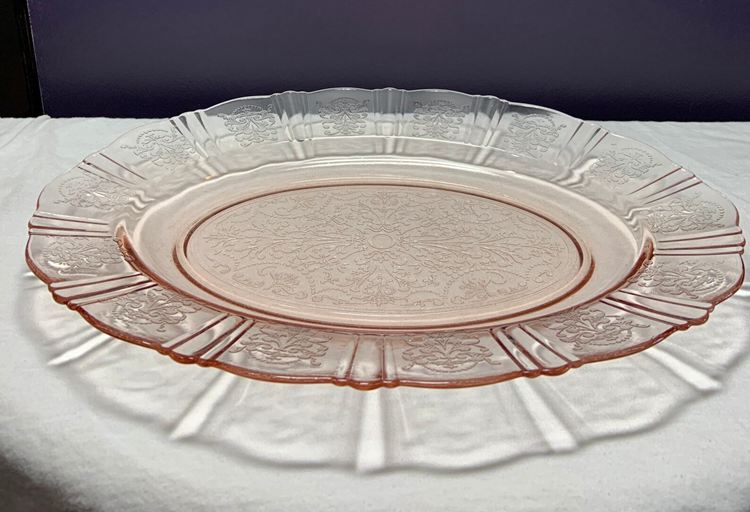
20. The Cameo Pattern
The cameo pattern was the brainchild of the Anchor Hocking Glass Company, and it was released between 1930 and 1934.
The Anchor Hocking Glass Company was another prolific pink depression glass company in those days, although they were famous for adding other exciting colors to their designs.
This particular pattern was also known as the Dancing Girl or Ballerina pattern back then. It was so called because the glass had an image of a ballerina dancing on the side.
The cameo pattern has a long and exciting history. The Hocking glass company got the design for this pattern from the Monongah Glass Company of Fairmont, West Virginia, which they acquired in 1924.
The pattern was initially called “Springtime” and was hand molded by the Monongah before pink depression glass, and other depression glass became popular.
The Hocking glass company adjusted the molds in the design to make them easy for machine pressing while copying the pattern almost wholly. As a result, the pattern grew to become one of the most popular patterns recorded in the great depression era.
Cameo patterns exist in crystal, pink and yellow pieces. However, of all three pieces, the pink depression glass materials are the rarest and most difficult to find, while green glassware is often commonly found.
You can find cameo patterns in depression glassware, like cookie jars, plates, cups, pitchers, and jugs. Depending on the kind you own and the condition, you can sell it on an online trading platform like Etsy for a wide range of prices.
You can sell a ballerina pattern cookie jar for $65 or more, while a vintage green ballerina pattern pitcher could go for 7o bucks.
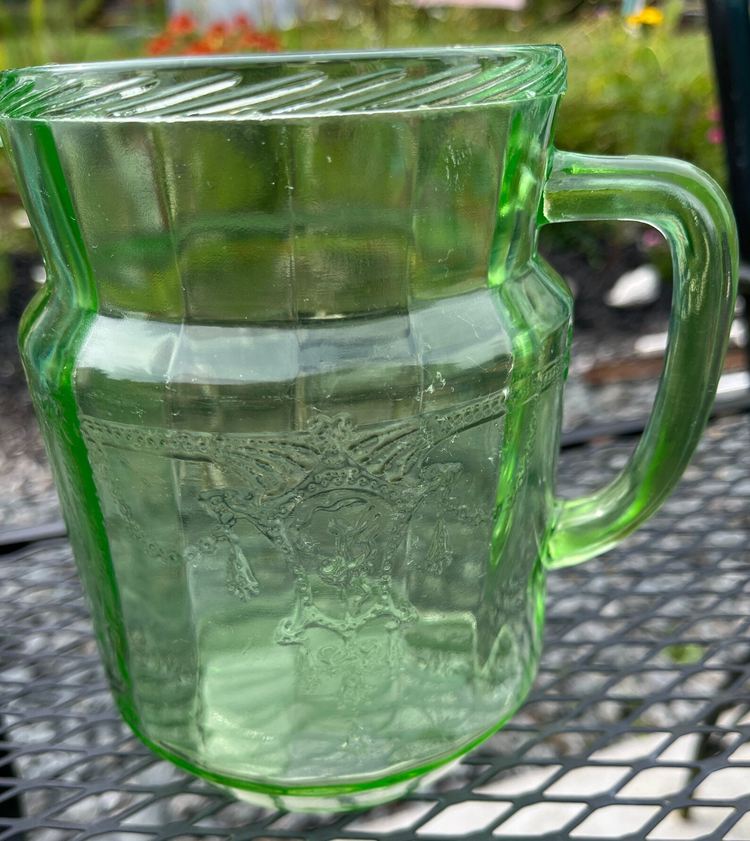
19. Royal Lace Pattern
The royal lace pattern was a creation of the Hazel Atlas Glass Company between 1934 and 1941. Although it has one of the most straightforward depression glass designs, it has become one of the most popular colored patterns of all glassware made during the era of the great depression.
The Hazel atlas glass company is another glass company known for making authentic depression glass designs during the great depression. This particular piece is known for its signature blue glass, which was designed and released between 1936 and 1941.
Hazel Atlas glass makers made the blue glassware from the leftovers of the Shirley temple sets. These sets were made for General Mills, but no one was interested in buying them. So Hazel Atlas then remade them by passing them through the royal lace molds.
Today, the royal lace blue is more valuable than the pink depression glass and other colored patterns made by the Hazel atlas glass company.
The royal lace depression glass pattern is one of the most expensive and widely collected patterns in antique stores today. This pattern has many glass cookware, like glass cups, creamers, cookie jars, and salt & pepper shakers.
Depending on the kind you have, the colored glass can be worth different prices to you. For example, you can sell a blue royal lace creamer in mint condition on Etsy for $200 or more. However, a royal lace pink depression glass cookie jar might be worth around 15 bucks.
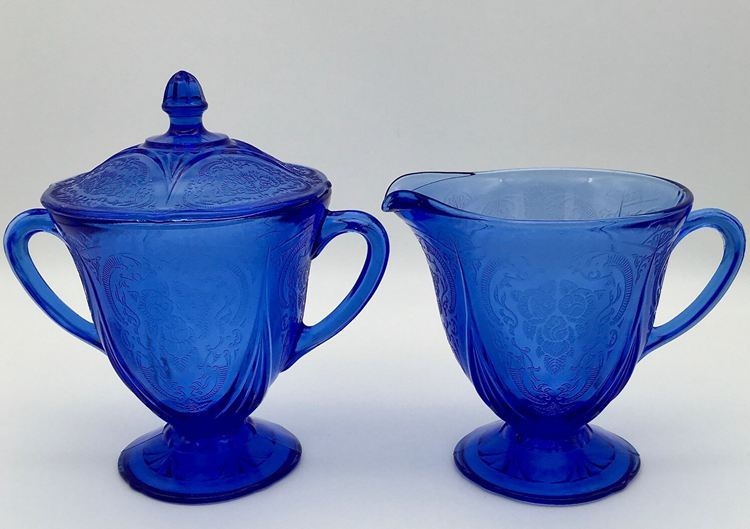
18. Patrician Pattern
The patrician pattern was one of several patterns made by the Federal glass company between 1933 to 1937. This pattern was unique in its design because of its simplicity. It was found in all kinds of glassware, from saucers to plates, cups, and pitchers.
The patrician pattern, also known as the Spoke pattern, has a pentagon shape in the center, with 5 spokes (they look like 6 at first glance).
Although Federal Glass Company made the glassware in different colors like amber, crystal, green, and pink, today, only the green and pink depression glass are highly valuable and desirable. So today, if you have the patrician glass, you can sell it for up to $30 on Etsy.
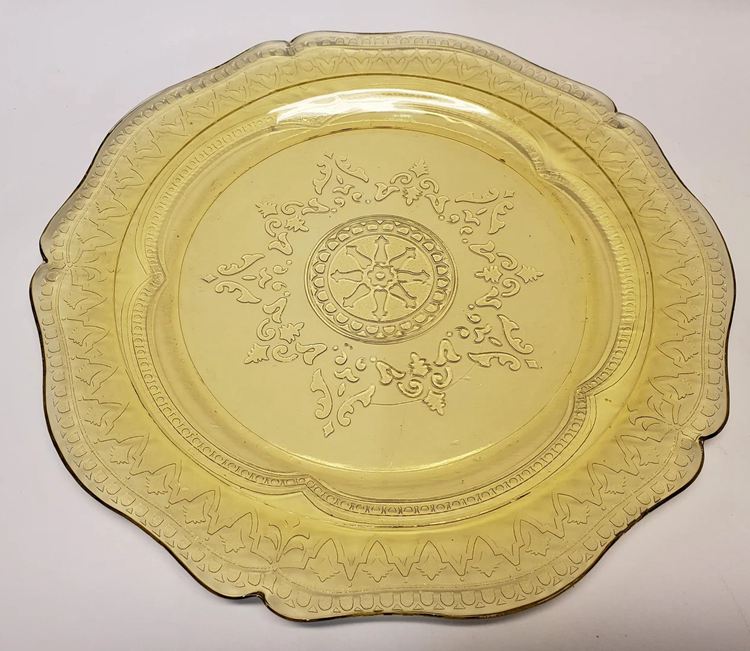
17. The Mayfair Pattern
The Mayfair pattern is another beautiful design by the Anchor hocking glass company. This pattern was also called “open rose” by the users because of its design. It was an elegant glass pattern manufactured and released between 1931 and 1937.
The pink depression glass made out of this pattern is extremely common and the most popular among all the colored glass patterns made from this design. The hocking glass company also made the design in yellow, green, and blue.
This glass design was made into different kitchen cookware, like the cup, jar, butter dish, and plate. Today, depending on the condition of the glass cookware, you could sell a Mayfair pattern pink depression glass on Etsy for $90 or more.
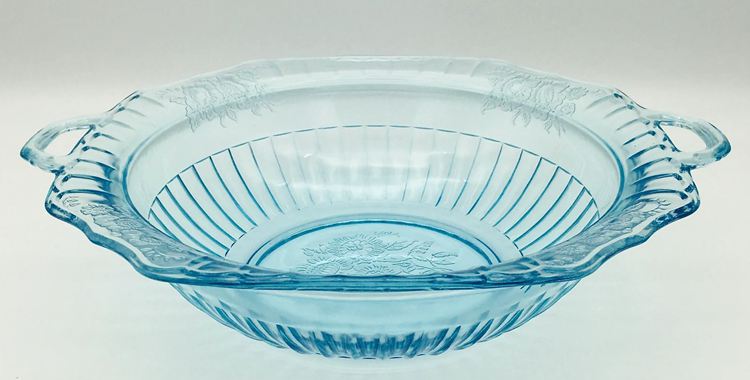
16. The Princess Pattern
The princess pattern is another authentic depression glass pattern created by the Hocking glass company. This depression-era glassware was manufactured and released between 1931 and 1934.
When princess pattern depression glass came out, they were loved by many people because of its thoughtful designs and scalloped edges, which were very popular. Glass makers used them in plates, cups, pitchers, etc.
This pattern came in different colors, like topaz, green and pink depression glass. Today, they are pieces of depression glass worth some good money if you have them.
If you have a princess pattern pink depression glass plate, you can sell it for $30 or more on Etsy.
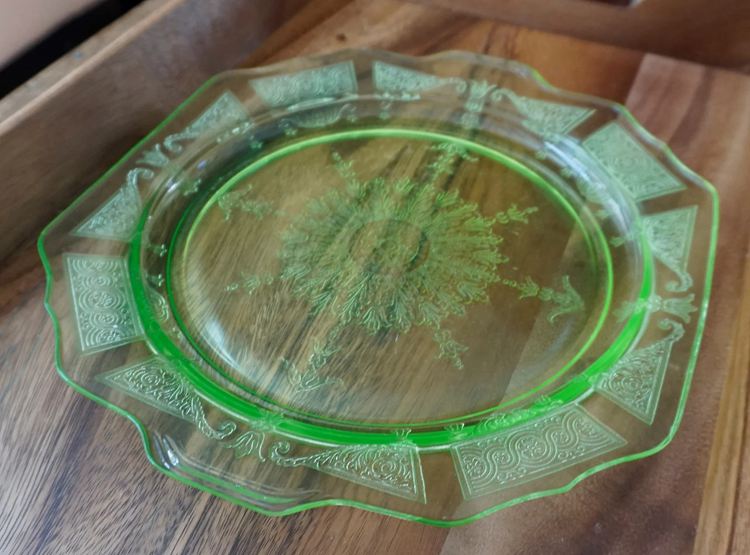
15. The Anchor Hocking Moonstone
The Hocking glass company designed, manufactured, and released the Anchor hocking moonstone between 1942 and 1946. However, the glass was not technically real depression glass since it was created and released just after the depression era.
The glass patterns are just as beautiful as the name. It was released in just one colored style, with a clear, transparent pattern and a white opal at the tips.
It came in different cookware, like plates, cups, goblets, and creamers. If you have an anchor hocking moonstone glass in good condition, you can sell it for $20 or more on Etsy.
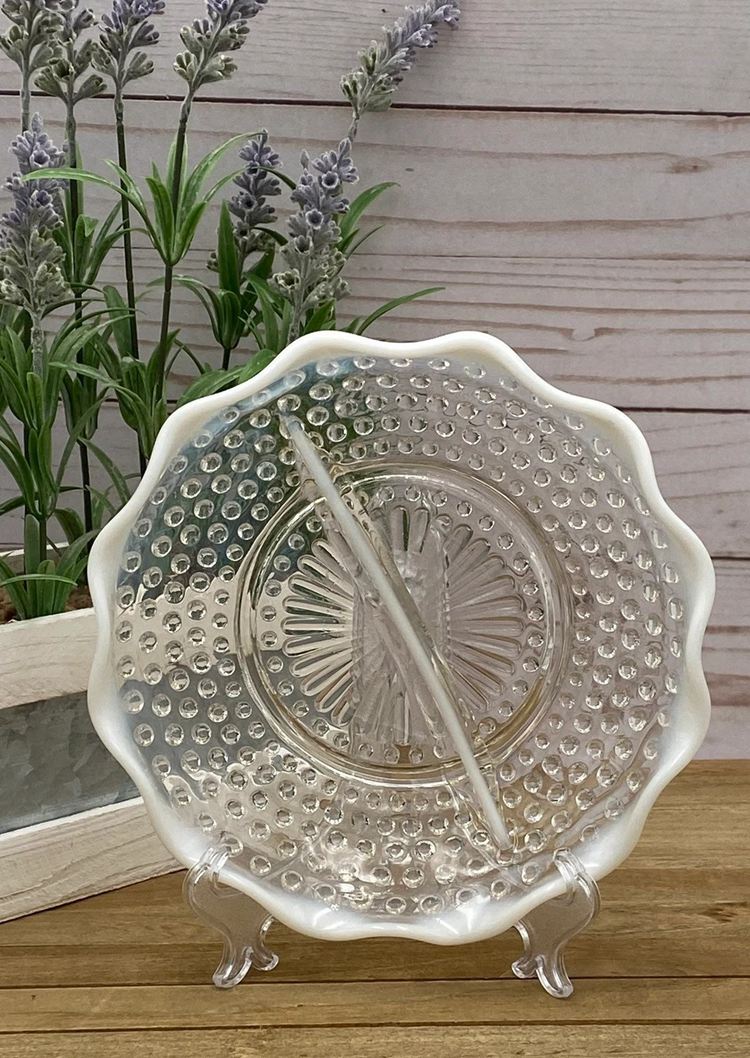
14. The Sunflower Pattern
The sunflower pattern was created and released by the Jeannette Glass Company between 1934 and 1941. As the name implies, the pattern has designs of sunflowers all around the body and one large one in the center
Jeannette glass company was a prolific name during the depression glass period, and they managed to make some rare pieces for cookware and other glassware. The sunflower pattern is found on plates, cups, serving trays, and even vintage cake stand.
Of course, there was a pink depression glass for this colored pattern, but there were other colors too, like transparent green, amber, and royal blue.
You can sell a sunflower pattern depression glass on Etsy or eBay for $30 or more, depending on the condition and type of cookware.
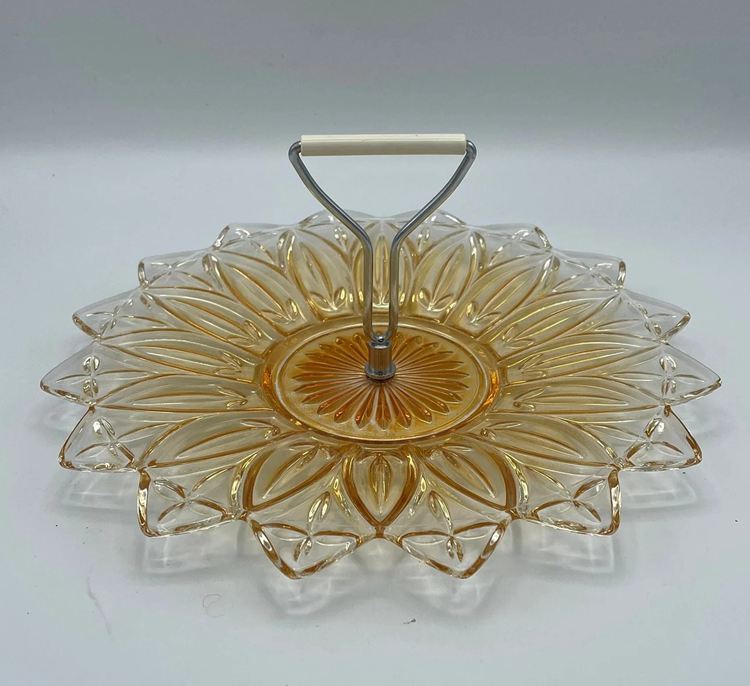
13. Aurora Cobalt Blue Pattern
The Hazel Atlas glass company made the Aurora cobalt blue pattern strictly for breakfast sets in the late 1930s. This means the Aurora pattern is minimal since it is restricted to one color and one type of glassware.
The aurora pattern had just a cup and a saucer in its significant designs. There is also a cereal bowl and a serving bowl, both in the same color. There is no pink depression glass using these patterns.
If you have an aurora blue pattern breakfast set, you can sell it for as much as $30 or more on Etsy.
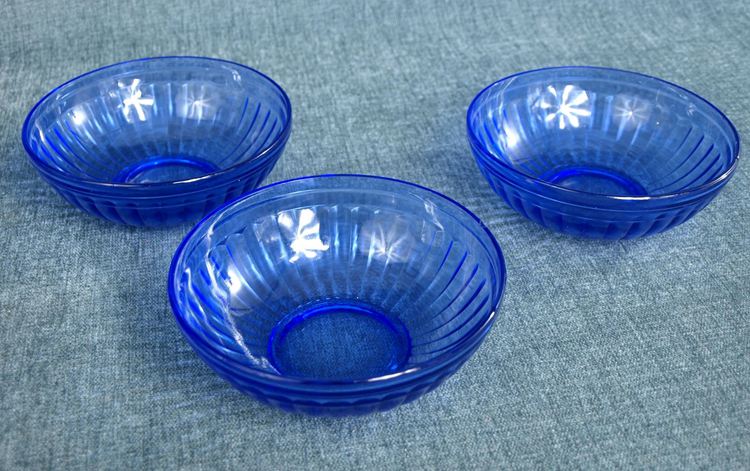
12. Block Optic Pattern
The Block optic pattern is another beautiful depression glass from the hocking glass company. The design ran from the late 1920s until the mid-1930s and captured many hearts with its simple but elegant design.
Although many common ones have come in green, there are also block optic glasses made in pink, white, and yellow. To show how loved they were, they were prevalent in flea markets everywhere, but now they have become scarce.
The design of this pattern came in many glasswares, like jugs, pitchers, sugar bowls, creamers, and cups. If you have one with smooth edges and in good condition, you can sell it for up to $150 or more
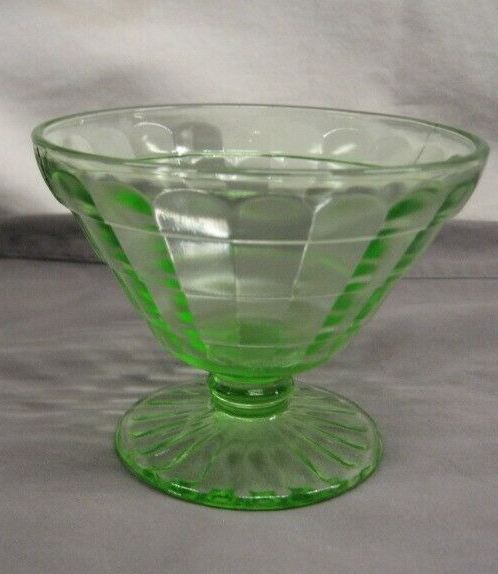
11.The Waterford Pattern
This is yet another beautiful design from the Anchor Hocking glass company, released and used between 1938 and 1944.
The Waterford pattern wasn’t one of the common patterns people were used to in those days. Instead, it had a crosshatch waffle pattern on all its glassware. Because of this, this design is also known as the waffle pattern.
It has a crystal and a pink depression glass and doesn’t come in any other color. It came in different glassware like cups, pitchers, cake serving plates, bowls, etc. You can also find a Waterford pattern butter dish.
Today, you can sell your waffle pattern depression glass on Etsy or eBay for $30 or more. A giant pitcher could fetch you a few hundred dollars or more.
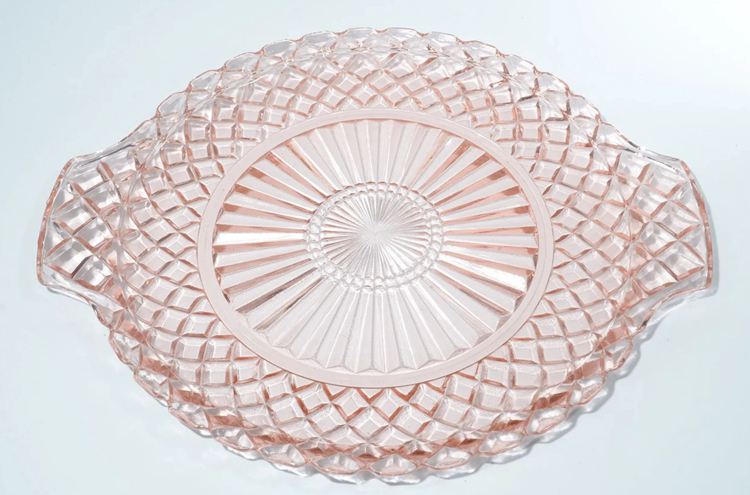
10. Windsor Pattern
The Windsor pattern was manufactured and released by the Jeannette glass company between 1936 and 1946. Although it was not one of the more popular patterns, it had a good run and was loved by many people then.
Also known as the Windsor Diamond, the Windsor pattern was made mainly in pink, crystal, and green. It encompassed much glassware, from pitchers to cups and plates.
Today, with well-maintained Windsor pattern glassware, you can make $40 or more selling it on Etsy. But, of course, the most valuable item is the pink depression glass pitcher.
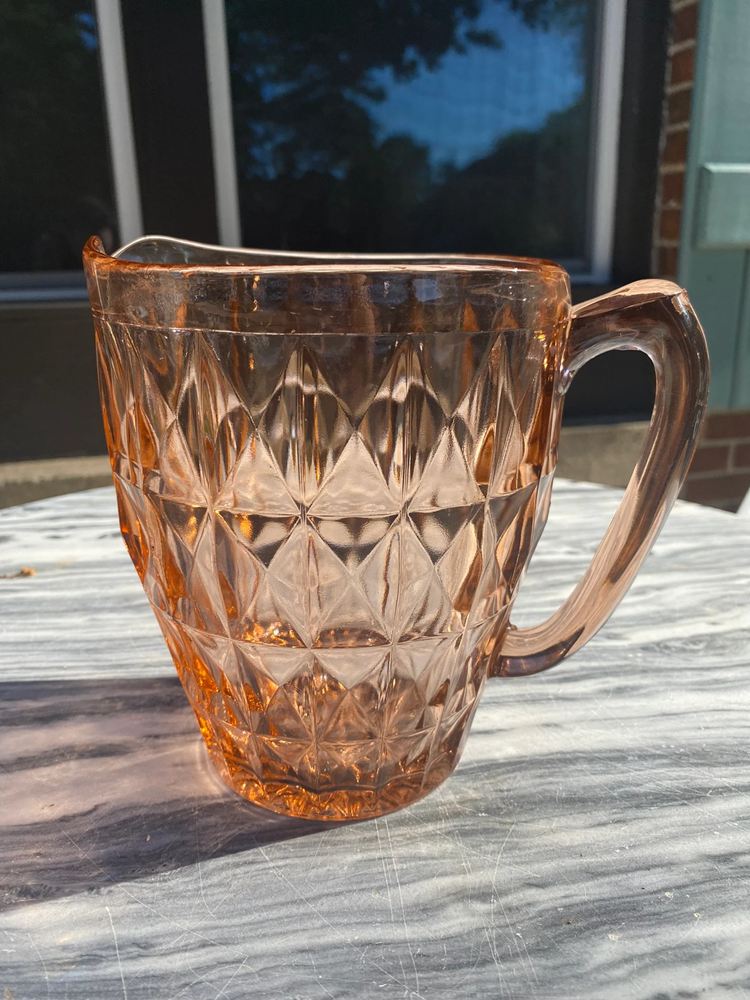
9. The Cherry Blossom Pattern
The cherry blossom pattern was another good work from the Jeannette glass company between 1930 and 1939. Just as the name implies, the design was shaped like cherry blossoms and flowers.
This design was made in many different colors, like pink, green, opaque, blue, and clear shades. It also had many glassware, like plates, bowls, cups, etc.
Today, a pink depression glass center bowl with minor scratches could earn you up to $70 or more when you sell it on a platform like Etsy.
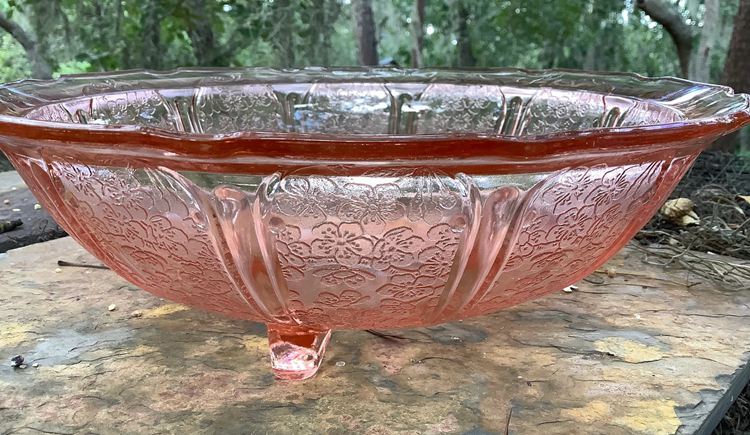
8. Golden Gilt Pattern
The Golden Gilt pattern depression glass was popular in the late 1920s till the middle of the 1930s. Surprisingly, no one knows the brand behind the creation of this rare and beautiful glassware, but people love it for its design.
A lot of big companies took on the challenge of creating depression glass in those days, but so did small, unknown companies. For this reason, we don’t know the origins of some of the finest depression glass since the more reputable brands did not create them.
The major depression glass with this design is the amber golden gilt bowl. Today, you can get those bowls on sites like eBay for about $89.
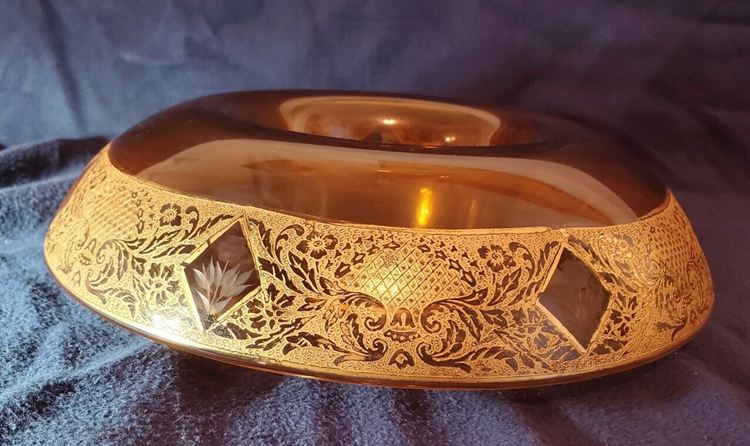
7. Fire King Sherbet Depression Glass Pattern
The Hocking glass company manufactured the Fire King Sherbet design at the height of the great depression. Because many families were struggling financially and couldn’t afford to buy glass, gas stations gave this glassware to people who spent a certain amount.
People also gave out this glassware to people who bought some amount of oatmeal. Because of this, this depression glass is also called “oatmeal glass.”
If you can find a complete set of three oatmeal depression glasses, either clear or crystal, you can sell them for about $15 or more on eBay.
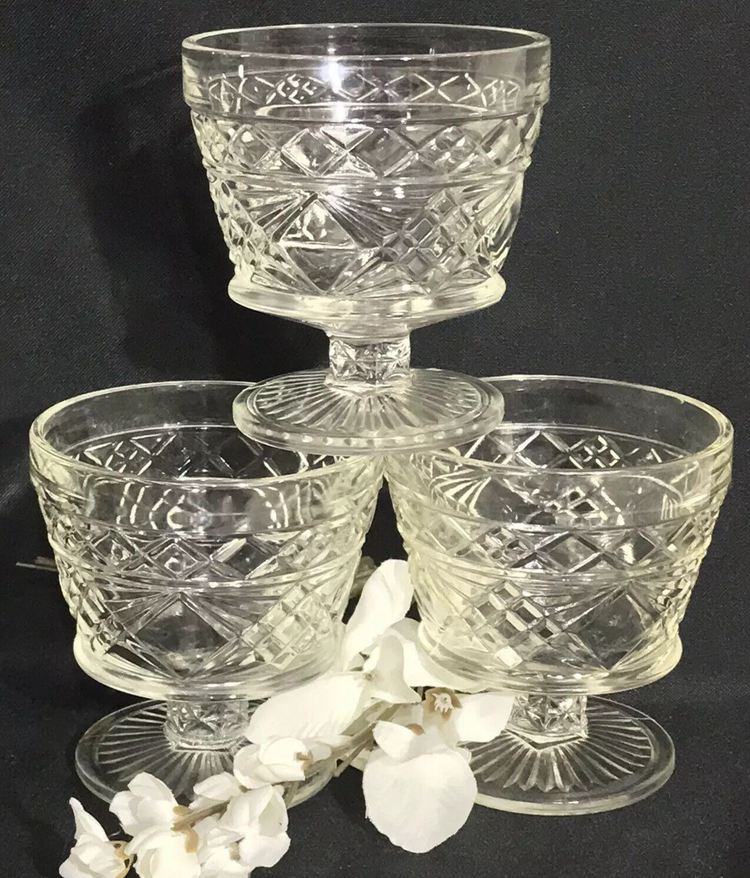
6. Authentic French Neon Depression Glass
When depression glass became popular, the market was flooded with pink depression glass and other colored patterns like amber, blue, and crystal. However, one color that stood out because of its rareness and beauty was Neon.
A clean set of authentic depression glass made using neon was made by Pernod Fils and is so rare now that it is difficult to find in online antique stores. However, if you are fortunate to have some of these antique items, you can sell them for up to $200 on a site like Etsy.
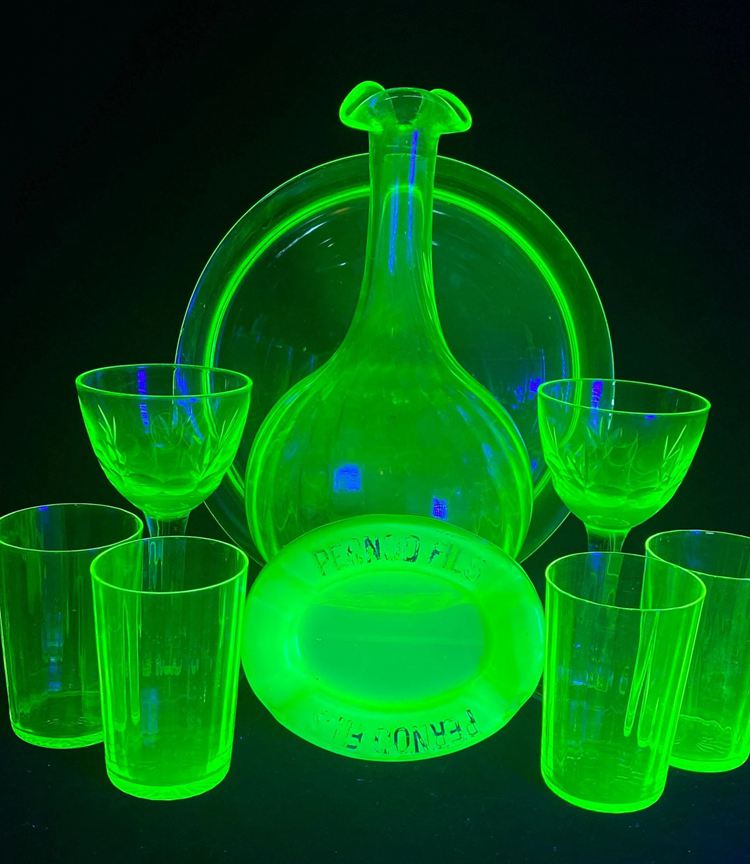
5. Rosemary Glass Pattern
The Rosemary Glass Pattern is one of the rarest depression glass patterns available today. It was created by the Federal glass company between 1935 and 1937. The design is very similar to the Mayfair pattern and has roses all over the edges of the glassware.
The main difference is that the Mayfair pattern has a scalloped edge while the rosemary pattern has a smooth edge.
Although amber is the most popular color, other colors like pink exist. The pink depression glass was made in a limited edition, so it is the rarest. It is also called rose glow because of its rosy color.
You can sell rosemary glassware for about $40 today.
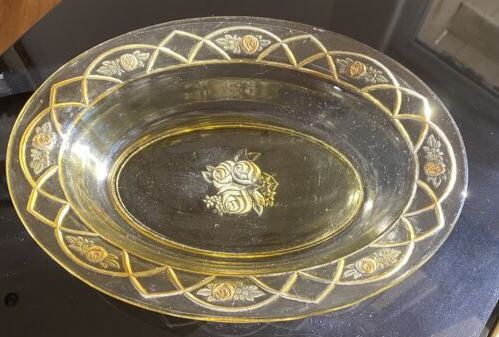
4. Star of David Pattern
The star of David pattern was one of the most enduring depression glass pieces, lasting until 1978. It is one of the most valuable pink depression glass pieces globally.
This pattern has designs of many stars across the glassware, with one large star in the center to connect all of them. The Hocking glass company manufactured it in the 1930s, and they got their inspiration from the Jewish star of David.
The Hocking Glass company used the pattern to make much glassware, like plates, cups, and bowls. If you have a star of David pattern pink depression glass, you can sell it for $20 or more on Etsy.
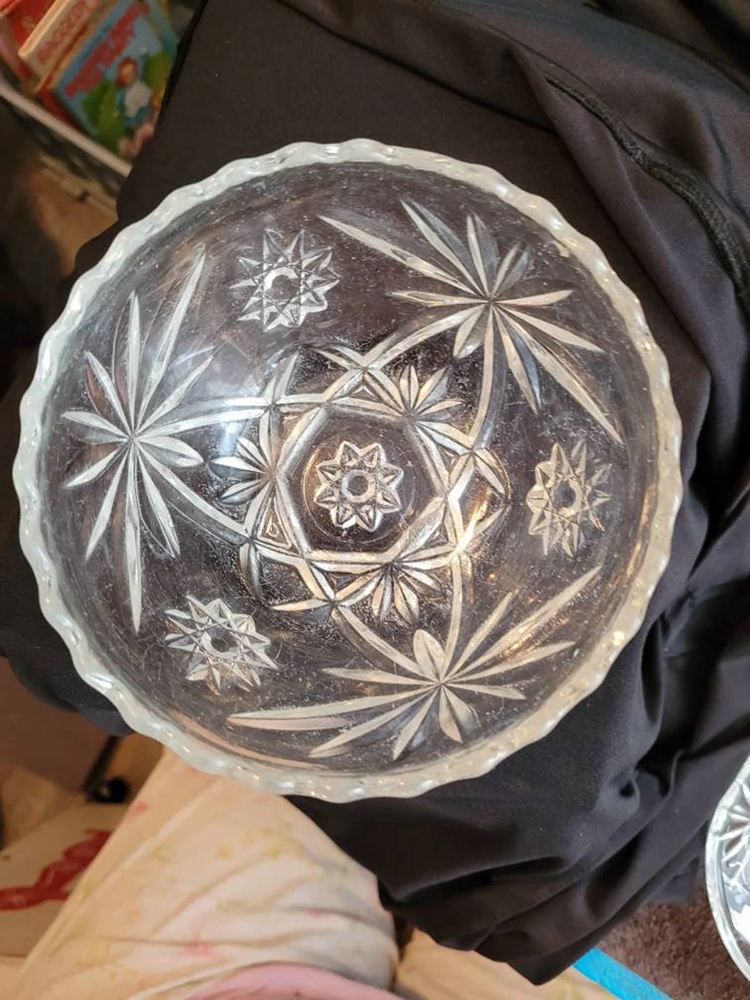
3. Stippled Grape Pattern
This pattern was manufactured and released by the Westmoreland Glass Company in 1940, and it is a true beauty to behold. It is not as common as some others on this list, but that makes it even more special.
It has a pink depression glass piece among its designs and other colors like green. People knew it as Woolworth green when it first came out. It gives a nice glow when illuminated and is available in many cookware.
You can sell it today on eBay for $15.
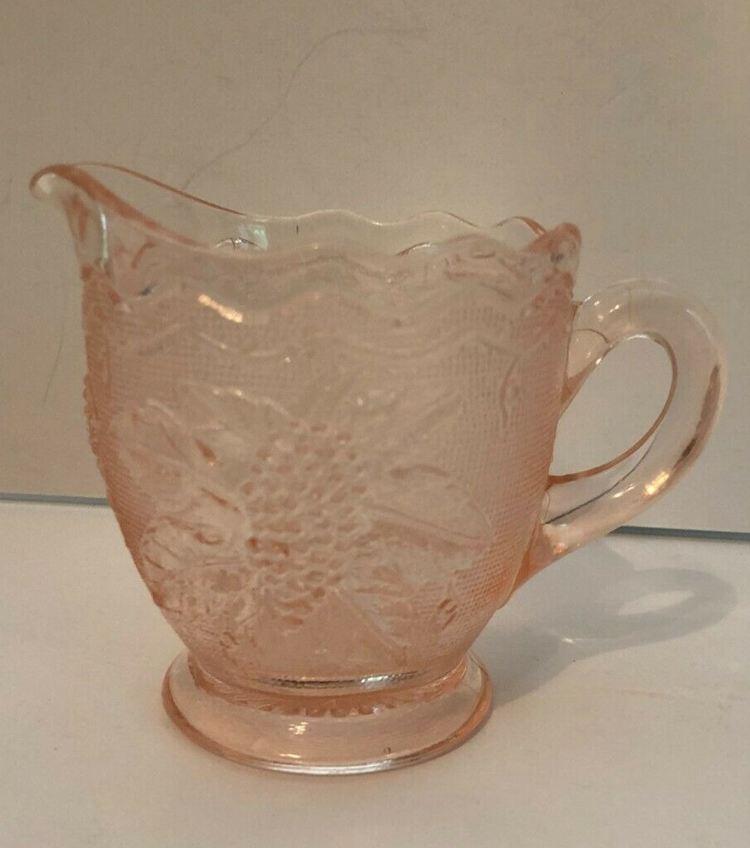
2. Buttons And Bows Pattern
The buttons and bows pattern is a pink depression glass pattern released between 1947 and 1949. It was produced by the Jeannette glass company and mainly had pink glassware, although some crystal ones exist too.
It was called buttons and bows because of its distinctive pattern that looks like a button surrounded by bows.
Today, you can find them in different cookware, like pitchers, cups, and plates. If you have one, you can sell them for more than $200.
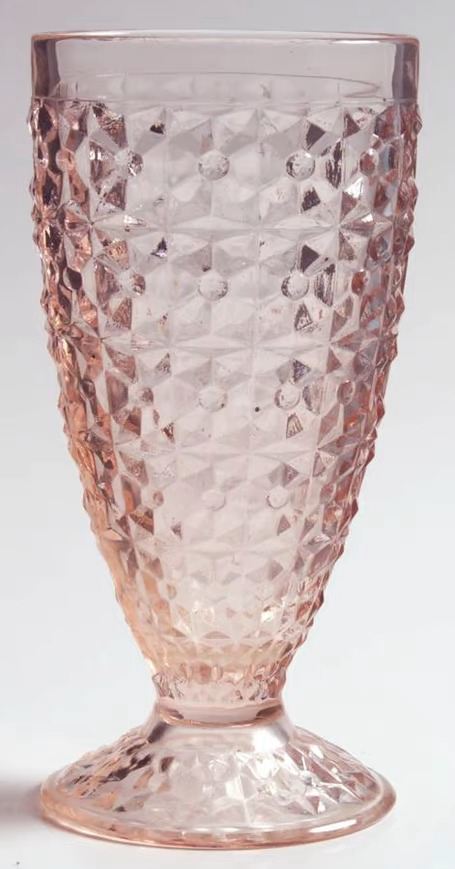
1. The Old Colony Glass Pattern
The old colony glass pattern is another masterpiece from the Hocking glass company, manufactured and used between 1935 and 1938. The glass company made it mainly in pink.
Although this pink depression glass was the most common, there were other color patterns like topaz and green. If you have the butter dish or goldfish bowl, you will appreciate the beauty in this pattern, like many collectors.
You can sell an old colony glass bowl for $15 or more on a site like eBay.
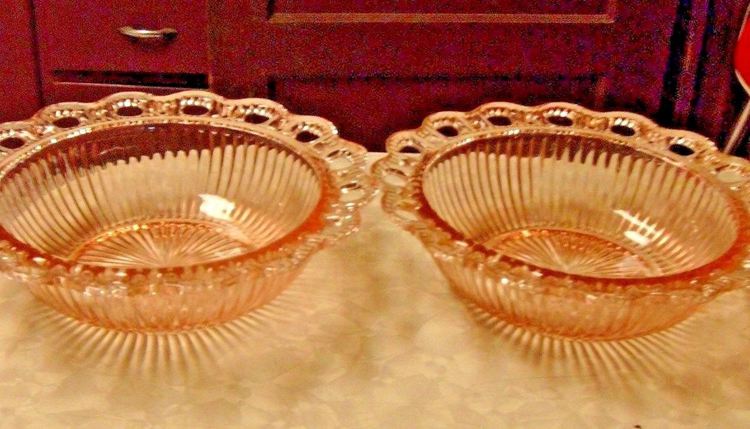
Conclusion
Hopefully, this guide has been helpful in showing you some of the best glass patterns to keep an eye out for if you are interested in buying or selling vintage pink depression glass sets.
If you have these depression glasses in good condition with only the original flaws, you can sell them at the prices listed in this article or even more.
The design, type of cookware, and size also affect the price of the pink depression glass.
For example, a pattern with intricate geometric shapes will probably cost more than another one with a bland design. On the other hand, some glassware will get particular attention because of its solid design.
Also, an item like a pitcher will cost more than a small cup.





![Where To Sell Antique Furniture In 2022 [Ultimate Guide]](https://www.jacquelinestallone.com/wp-content/uploads/2022/09/Etsy-Your-Place-To-Buy-And-Sell-All-Things-Handmade-600x450.jpg)


